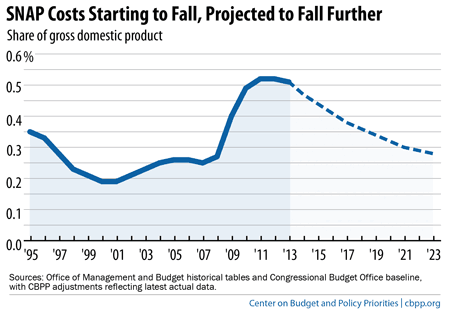BEYOND THE NUMBERS
Our new report has important news for House and Senate negotiators considering SNAP (food stamp) cuts as part of the Farm Bill: recent government data show that SNAP spending, which doubled as a share of the economy (gross domestic product or GDP) in the wake of the Great Recession, fell as a share of GDP in fiscal year 2013, which ended September 30. Moreover, CBPP projects that, in fiscal year 2014, SNAP spending will not only continue to decline as a share of GDP but will fall 5 percent in nominal (non-inflation-adjusted) terms, largely because of the expiration this month of the 2009 Recovery Act’s benefit increase.
And, as the economic recovery continues and fewer low-income people qualify for SNAP, the Congressional Budget Office (CBO) expects SNAP spending to fall further in future years, returning to its 1995 levels by 2019 (see graph). Because SNAP isn’t projected to grow faster than the economy, it isn’t contributing to the nation’s long-term budget imbalance.

SNAP spending primarily reflects the number of participants and their average benefit:
- Participation has leveled off. Consistent with patterns from previous recessions, the number of SNAP participants rose substantially between 2007 and 2011. Caseloads leveled off in 2011 and 2012 and have remained essentially flat for the past year. This is true across the nation: state data for recent months show small participation declines in about half the states and small increases in the other half. As the economy improves, CBO expects the number of participants to fall by 2 to 5 percent each year over the next decade: from 47.7 million in fiscal year 2013 to 47.6 million in 2014, 46.5 million in 2015, and 34.3 million by 2023.
- Benefits have dropped. The expiration of the Recovery Act benefit increase cut SNAP benefits for all households by 7 percent, on average, or about $5 billion for fiscal year 2014. In future years, SNAP benefits will simply keep pace with food price inflation.
Some critics have called for large cuts in SNAP — like the House-passed bill to cut a couple million people off the program — in part on the grounds that SNAP is growing out of control. But these recent data show that that the spending growth has ended and that SNAP is following the pattern of previous recessions, as CBO and other experts expected.
